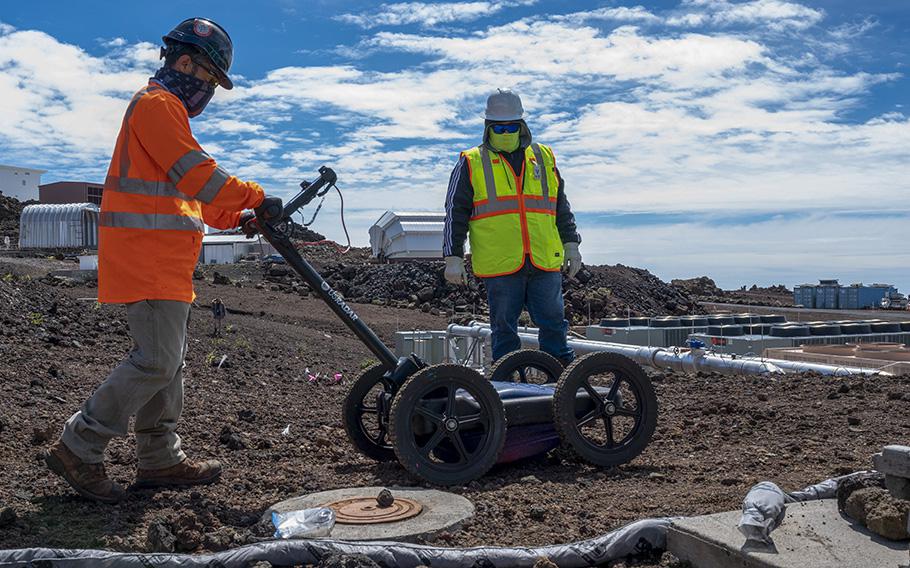
Contractors use a ground-penetrating radar to identify and map utility pipes and wires under the ground at the Maui Space Surveillance Complex on the island of Maui, Hawaii on Feb. 21, 2023. After mapping utilities under the ground, contractors will excavate soil around the generator which was contaminated during a recent fuel spill. (Jimmie D. Pike/ U.S. Air Force)
(Tribune News Service) — The Air Force announced Tuesday that phase one of its excavation at the Space Force’s Maui Space Surveillance Complex following a diesel leak was completed on March 22.
The effort is being overseen by the Air Force Civil Engineer Center, which is working to remediate the area after an estimated 700 gallons of diesel began leaking from a generator on the night of Jan. 29 after a power surge at the site during a storm.
In a news release, the Air Force said workers removed approximately 43 sacks of soil weighing an estimated 84, 000 pounds and replaced it with soil collected at a nearby site.
“The soil removed is being safely stored at the summit of Haleakal ā until a remediation plan is approved in phase three, “ the Air Force said in the release. “Excavation averaged to about three feet depth of previously disturbed soil, due to slope and safety limitations.”
Military officials say the leak began when a pump on a backup generator failed to shut off and continued until maintenance personnel discovered the pump was still on and shut it off around 8 a.m. the next day. They believe the power surge damaged a “regulation float, “ causing the generator to malfunction and take on excess fuel.
The float rests on top of the fuel in a manner similar to the float in a toilet tank. When the fuel drops to a certain level, the float is designed to call for more fuel, and then a transfer pump moves fuel from a storage tank into the generator’s main tank as fuel in that main tank rises. The float is designed to then send a signal to the transfer pump to turn off. But that night, diesel kept flowing.
The Air Force said it is exploring replacing the generator with a smaller and more efficient one that would require less fuel, as well as “exploring the addition of a tertiary containment system to prevent a future mishap.”
“We are working seven days a week, weather permitting, in order to safely and respectfully restore this sensitive site, “ said Space Force Col. Marc Brock in the news release. “We recognize the significance of Halea kala, and we have a special obligation to care for it.”
The Space Force, established in 2019 under the Department of the Air Force, is the youngest and smallest branch of the U.S. military.
In 2022, Brig. Gen. Anthony Mastalir arrived in Hawaii and became commander of the newly established U.S. Space Forces Indo-Pacific, leading a small group of fewer than 100 highly specialized troops who work to ensure that service members from other branches have ready access to satellite systems and communications to support their own operations.
In its media release, the Air Force said that “at more than 10, 000 feet elevation, the location atop Haleakala provides some of the best astronomical viewing conditions on Earth.” But the Maui spill came at a time when many Hawaii residents are reassessing their relationship with the military amid a series of fuel and chemical spills in the islands.
In November 2021, fuel from the underground Red Hill fuel storage facility contaminated the Navy’s Oahu water system, which serves 93, 000 people. The World War II-era fuel farm, which holds about 104 million gallons of fuel, sits just 100 feet above a critical aquifer that most of Honolulu relies on for clean water.
Further revelations about potential water contamination by toxic “forever chemicals “ used in firefighting materials at the Red Hill facility and the Hawaii National Guard’s Waiawa facility has only heightened scrutiny of the military’s handling of toxic materials in the islands as the Pentagon steps up operations in the Pacific and commanders prepare to renegotiate land leases that expire in 2029.
The Air Force said a contract for phase two of its work on Haleakala is set to be awarded by the end of March, with the Air Force developing a plan that will need approval from the state Department of Health.
Phase two will involve taking core samples at depths of 40, 80 and 200 feet to determine the scope of contamination, with work slated to begin in in May. The Air Force said lab results from that sampling “will guide the phase three remediation plan ; the phase two report should be available by August.”
(c)2023 The Honolulu Star-Advertiser
Visit The Honolulu Star-Advertiser at www.staradvertiser.com
Distributed by Tribune Content Agency, LLC.